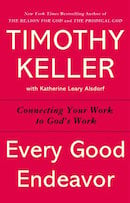Simplicity at Work: Finding our Essence
Blog / Produced by The High Calling
In a high-tech, high-speed world that feels complicated, distracting, and overwhelming, is it any wonder that people are seeking to simplify? Even the president of the United States realizes the wisdom in simplicity. In "Obama's Way," a 2012 Vanity Fair article by Michael Lewis, the president is quoted as saying, “You’ll see I wear only gray or blue suits...I’m trying to pare down decisions. I don’t want to make decisions about what I’m eating or wearing. Because I have too many other decisions to make.” The president further advised, “You need to focus your decision-making energy. You need to routinize yourself. You can’t be going through the day distracted by trivia.”
Where can we simplify, avoiding distraction in order to complete more meaningful work? Would “routinizing” ourselves be a way to incorporate simplicity into our workplaces and processes? More subtly, what happens when simplicity works in us, changing the way we process and live out our days?
In her 99U article “On Keeping It Simple,” Jocelyn K. Glei quotes John Maeda, author of The Laws of Simplicity, “The simplest way to achieve simplicity is through thoughtful reduction.” Glei continues, “With a million different bits and bytes coming at us every day, simplicity isn’t just a design imperative any longer, it’s a productivity imperative – if not a sanity imperative...Anything that we can do to reduce our distractions and dial down the background noise is going to help us produce better work.”
Following Maeda’s advice, we can start with a practical approach and consider thoughtful reduction in our work spaces. We might streamline our agendas and rearrange our desktop to minimize movement; or we could reduce modes of communication, marketing approaches and the number of reports truly needed to monitor progress. By continually revisiting and rethinking processes, we can ask and discover, “Why are we doing this? Is there a simpler way?”
Billy Coffey’s mom found nursing easier than most of her colleagues because instead of relying on tests and techniques, she took a far simpler approach. “Don’t worry about the blood,” she told Billy. “Worry about the scars. The scars are what’s important.” She found that deep healing can come by connecting with people's pain.
Tsh Oxenreider discovered how to be more productive in her online life: by disconnecting from that online life. “This disconnect is a subtle, simple thing, but it reaps powerful fruit in my work life,” she explains. “By going off-line, I'm better focused, I'm able to single-task, and I can shut out potential voices of doubt or disappointment. I'm more willing to take necessary risks because I can only see what's right in front of me. My work feels simpler. Just do the next thing, one thing at a time.”
In a featured High Calling Community post, Kari Scare describes similar results through the power of her Master List, praising the simplicity of single-tasking. "[T]he more we divide our attention," she explains, "the less productive we are and the less quality work we produce. Conversely, when we stop trying to multitask and instead focus our attention, eliminate distractions as much as possible, and quit trying to be all things to all people, we find simplicity of focus that results in increased productivity and effectiveness."
When she was a young adult, Kimberly Conway Ireton thought minimizing complexity was the path to a simple life, to the Good Life. "But what I ended up with was a minimal life, devoid of beauty and joy," she explains. "If our eye is single, Jesus says, if we are focused, first and foremost, on him and his priorities, our whole being will be full of light—his light shining clarity on everything else we see." Katie Fox, in her daily reflection, offers a related thought: "Finding simplicity in our day-to-day vocations and callings begins on the inside; trusting in the Lord, and abiding in His presence."
Steve Jobs applied his love of simplicity at the design level, pushing for Apple products to have only what was absolutely essential. A 2012 Smithsonian Magazine article, “How Steve Jobs' Love of Simplicity Fueled A Design Revolution,” explains that design at Apple under Jobs’ direction “was not just about what a product looked like on the surface. It had to reflect the product’s essence.” To Jobs, simplicity isn’t “just minimalism or the absence of clutter. It involves digging through the depth of the complexity. To be truly simple, you have to go really deep. For example, to have no screws on something, you can end up having a product that is so convoluted and so complex...You have to deeply understand the essence of a product in order to be able to get rid of the parts that are not essential.”
If understanding the essence of a product requires us to dig deep, how much more must we work to understand the essence of ourselves! But Mark D. Roberts reminds of the reality of Resurrection power that resides in our essence: "The very Spirit of God lives in us to empower us for the ministry of the kingdom of God. Resurrection power is for us, in us, and at work through us."
We can benefit from the freedom and focus that comes from simplifying our systems and spaces, but any work to reduce and simplify our very selves should send us to our essence; and there, may we tap into the truth of Christ's Resurrection power in us, available as we go about the interactions, decisions and challenges of our daily work.
Simplicity at Work
In our complicated, 21st century, high-tech, high-speed world, people have begun to crave a simpler approach to life and work. In the series Simplicity at Work, The High Calling explores simplicity in the places we work and the ways we work; and, perhaps more subtly, we want to explore simplicity at work in us through a variety of stories that reveal ways people find freedom and success when they simplify. Join us for Bible reflections, featured articles, and discussion. Invite your colleagues to do the same.
Image by Alex. Used with permission. Sourced via Flickr.





